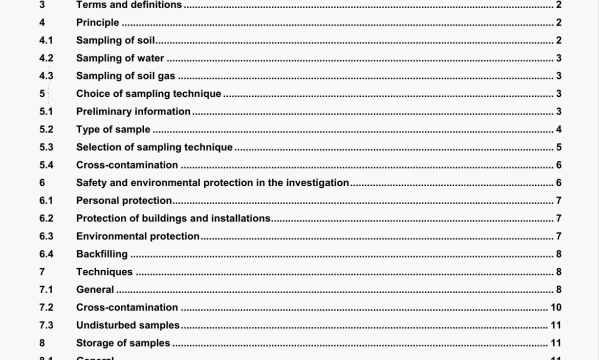ISO 10381-2 pdf download – Soil quality -Sampling —Part 2: Guidance on sampling techniques.
The choice of samplwig technique depends, an addition, on the required precision of the results. which in turn depends on the ranges of concentration of components, the sampling procedures and the type of analysis.
Sampling equipment should be carefully selected in relation to the different materials which may be present in the ground and the analysis to be carried out. Utmost care should be taken to avoid ctoss.contamlnation, loss of volatile compounds, change of composition due to exposure to sir, and other changes which may occur between sampling and the testing of the sample.
Every soil sampling technique usually consists of two separate steps:
a) gaining access to the point of sampling (removing the cover or sealing, digging or drdling a hole to reach the desired depth of sampling), and
b) taking the soil sample, Both steps depend on each other and both shall meet the req uwements of the sampling principles.
4.2 SamplIng of water
Sod investigation programmes, particidarly those carried out at contaminated sites, may also require water samples to be talcen. These should be collected in accordance with appropnate International Standards on ground or surface water sampling with regard to ground investigation. For further information see ISO 10381-1,
4.3 Sampling of soil gas
Ground investigation programmes may Involve assessment of soil gas composition for typical landfill gas components such as methane and carbon dioxide. In the case of contaminated sites, the suspected presence of solvents or fuels may require investigation. An International Standard (ISO 10381-7) is in the course of preparation to cover such investigations, and some indicative guidance Is incorporated in this part of ISO 10381.
5 Choice of sampling technique
5.1 PrelIminary Information
The choice of sampling technique, the selection of the sampling equipment and the method of takmg soil samples depends upon the objectives of the sampling, the strata to be sampled, the nature of possible contamination, and the examination or analysis to be carried out on the samples
Thus certain information Es needed to make this choice. This information may Include the size and topography of the area to be sampled,
— the nature of the ground to be sampled,
some mdicatlon of th. possible lateral and vertical variations of soil type or strata. the geology of the site and surrounding area.
— the depth to groundwater and its direction of 110w.
— the depths from which samples are to be taken, taking into consideration the future use of the site, including depth of excavations or foundations.
— previous usage or treatment of the site.
— the presence of tipped material above the level of the sate, or material from the demolition of buildings, location of water bodies at risk from contamination, including surface and ground water
Extreme natural ctcumstances, such as permafrost, latarization, caicrete or other induratxins. may occur which require special techniques in order to obtain samples. This shall be known prior to the design of a sampling programme.
To collect this information, a desk study or preliminary survey of the site is strongly recommended, When investigating soils suspected of contamination, the preliminary survey is an essential part of the investigation programme [see clause Sot ISO 10381.1:_Il and clause 6 of ISO 10381.5:_ti. Its mar relevant concerns are
a) to ensure an investigation which is both technicaly and cost effective;
b) to ensure the safety of personnel and to protect the environment.
The prelrinary survey may comprise both desktop studies and sate reconnaissance (field work). It does not normaly include taking samples, but ii some circumstances limited sampling may be useful in relation to determining the parameters for the site investigation, investigating some metholodical aspects, and Kientifying possible hazards to the rvestigating personneL
5.2 Type of sample
There are two basic types of sample which are collected for the purposes of rvesbgating soil and ground conditions, These are:
a) disturbed samples: samples obtained from the ground without any attempt to preserve the soil structure: that is the soil particles are collected loosW and are allowed to move in relation to each other:
b) undisturbed samples: samples obtained from the ground using a method designed to preserve the soil structure: I.e. special sampling equipment Is used so that the soil particles and voids cannot change from the distribution which exists In the ground before sampling.
ISO 10381-2 pdf download – Soil quality -Sampling —Part 2: Guidance on sampling techniques
